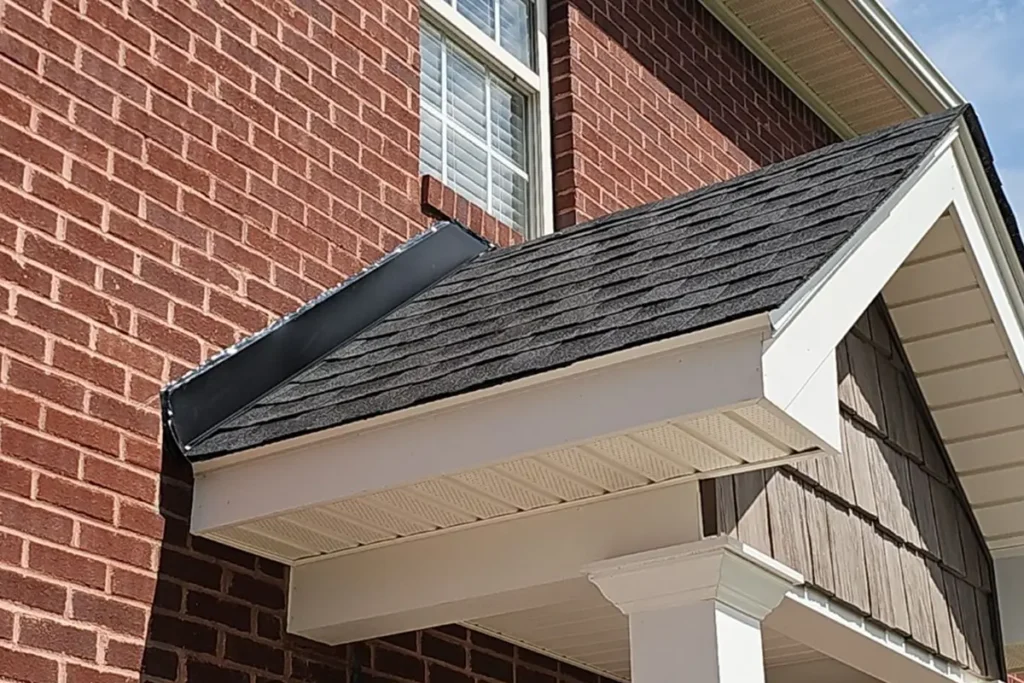What Is Roof Flashing and Why Does It Matter?
Flashing is a roofing component that is installed over the seams and gaps where sections of roofing meet, or where roofing meets components such as chimneys, vents, and skylights.
Typically made of metal, roof flashing protects the most vulnerable areas of your roof from moisture penetrating, making it essential to the functioning of your roof.
According to GAF, flashing is one of the most important roofing details because it directs water away from seams, joints, and other problem areas.
How to Spot Roof Flashing Damage Before It Becomes a Leak
Roof flashing plays a crucial role in keeping your roof watertight in vulnerable areas. Over time, however, roof flashing can sustain damage or become loose, leading to leaks and costly repairs. In this blog, the Gainesville roofing experts at Skyline Contracting break down the common causes of roof flashing damage, how to spot the warning signs, and what you can do to protect your home.
Why Flashing Fails: 4 Common Causes of Leaks
Like any part of your roofing system, flashing is exposed to the elements. Roof flashing may fail for reasons including:
- Damage due to storms, especially hail and high winds
- Installation errors
- Natural age and deterioration
- Poor maintenance
Noticed these signs? Schedule your roof inspection with Skyline Contracting before small issues turn into major repairs.

How to (Safely) Inspect Your Roof Flashing
If you suspect your roof flashing may be damaged, or if you haven’t inspected for a while, it’s a good idea to take a closer look. Homeowners can visually examine roof flashing, looking in areas around chimneys, roof vents, skylights, and sections of the roof where roof slopes come together.
While we don’t recommend walking on your roof—leave that to the professionals—you may want to use a ladder to get a closer look. Be sure to practice good ladder safety if you do so.
Top Signs of Roof Flashing Damage You Can’t Ignore
Look for the following signs of roof flashing damage as you complete your visual inspection:
- Small Holes – Water can seep through even the smallest cracks under the roof shingles. These tiny holes can cause rust and even attract wildlife if not sealed immediately.
- Missing or Loose Pieces – High winds and storms can move the flashing and detach some of its components. This can leave gaps, which create an opportunity for rainwater to penetrate.
- Rust or Corrosion – Even with galvanized coatings, roofing materials will rust over time due to exposure to different elements. When the corrosion becomes too problematic, your roof flashing will no longer be able to repel water and will need to be replaced.
- Damaged Siding – If you are starting to notice damage on your siding, the cause may be your roof flashing. If it’s not able to keep moisture away, your siding is one of the main areas that will suffer.
- Water Stains Inside Your Attic – Roof leaks are commonly caused by damage to flashing. If you’ve noticed leaks or signs of moisture intrusion in your attic, it could be an issue with your roof’s flashing.
When to Call a Professional Roofer
If you notice any of the above signs of flashing damage, it’s important to contact a professional roofer immediately. Damaged or deteriorated flashing is a major vulnerability for your roof, often leading to hidden leaks, mold, mildew, and damage to your roof’s underlying structure.
A flashing repair, on the other hand, can often be completed quickly and is much cheaper than a premature roof replacement.

Skyline Contracting: Roof Inspection Pros in Gainesville
At Skyline Contracting, as GAF Master Elite contractors, our detailed inspection process includes a thorough assessment of all roof flashing, identifying any signs of damage, potential failure, or vulnerabilities.
Our inspection process includes evaluating both the exterior and interior of your roof, along with full photo documentation and a consultation to share any recommendations we may have for your roof.
Protecting your roof is essential, and that includes a lot more than just your shingles! Book your roof inspection with Skyline Contracting today.
Roof Flashing and Maintenance FAQs
How often should flashing be checked?
Roof flashing, as with the rest of your roof, should be inspected at least once a year, as well as following any major storm events.
Can flashing be repaired or must it be replaced?
Typically, the way to repair roof flashing is to replace the affected section. Isolated damage can often be addressed by replacing a single piece, while more widespread issues may necessitate redoing the entire flashing system.
Is flashing damage covered by insurance?
Flashing damage may be covered by insurance if it was damaged by a covered peril such as hail or wind damage. Age or wear and tear is typically not covered by homeowners insurance, but it’s important to review your policy to be sure.
How much does it cost to fix roof flashing?
Fixing roof flashing may cost as little as $200 to replace individual sections, or $1,000 or more for larger-scale repairs or replacements.
